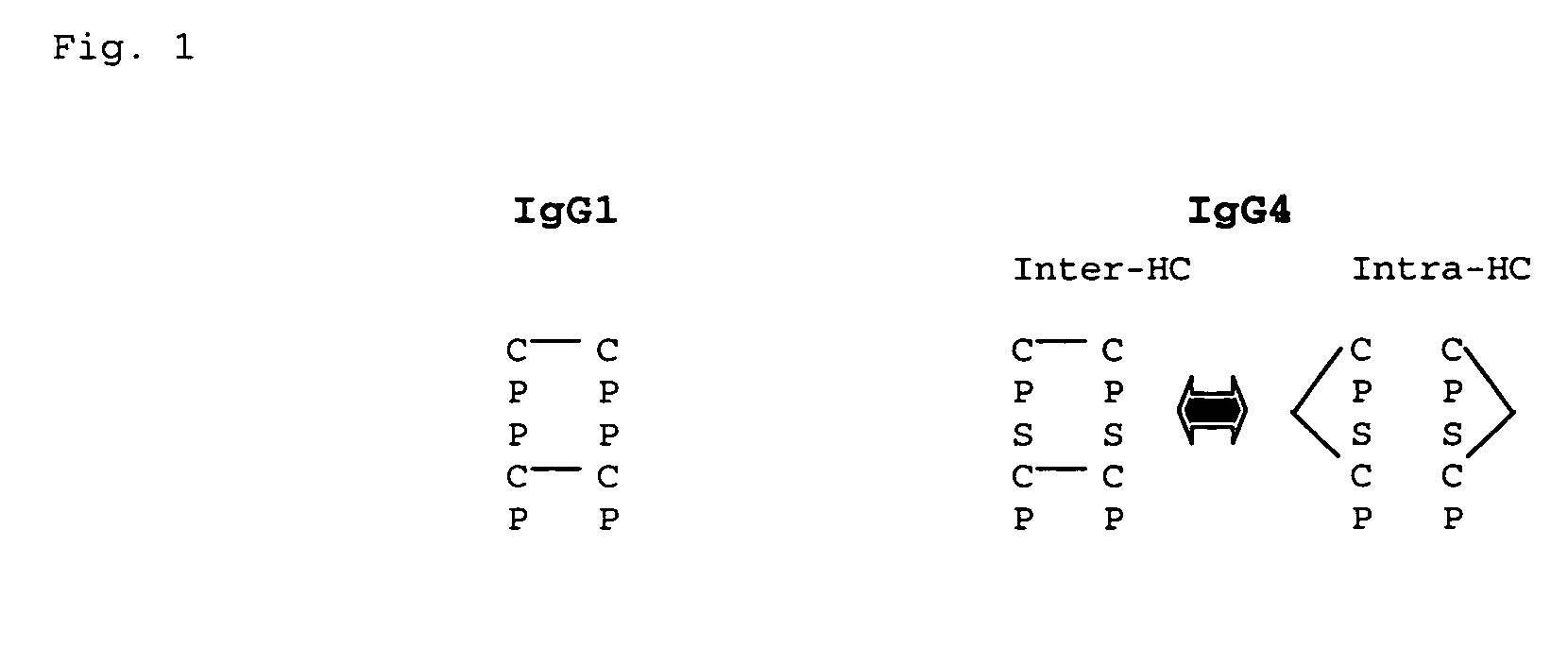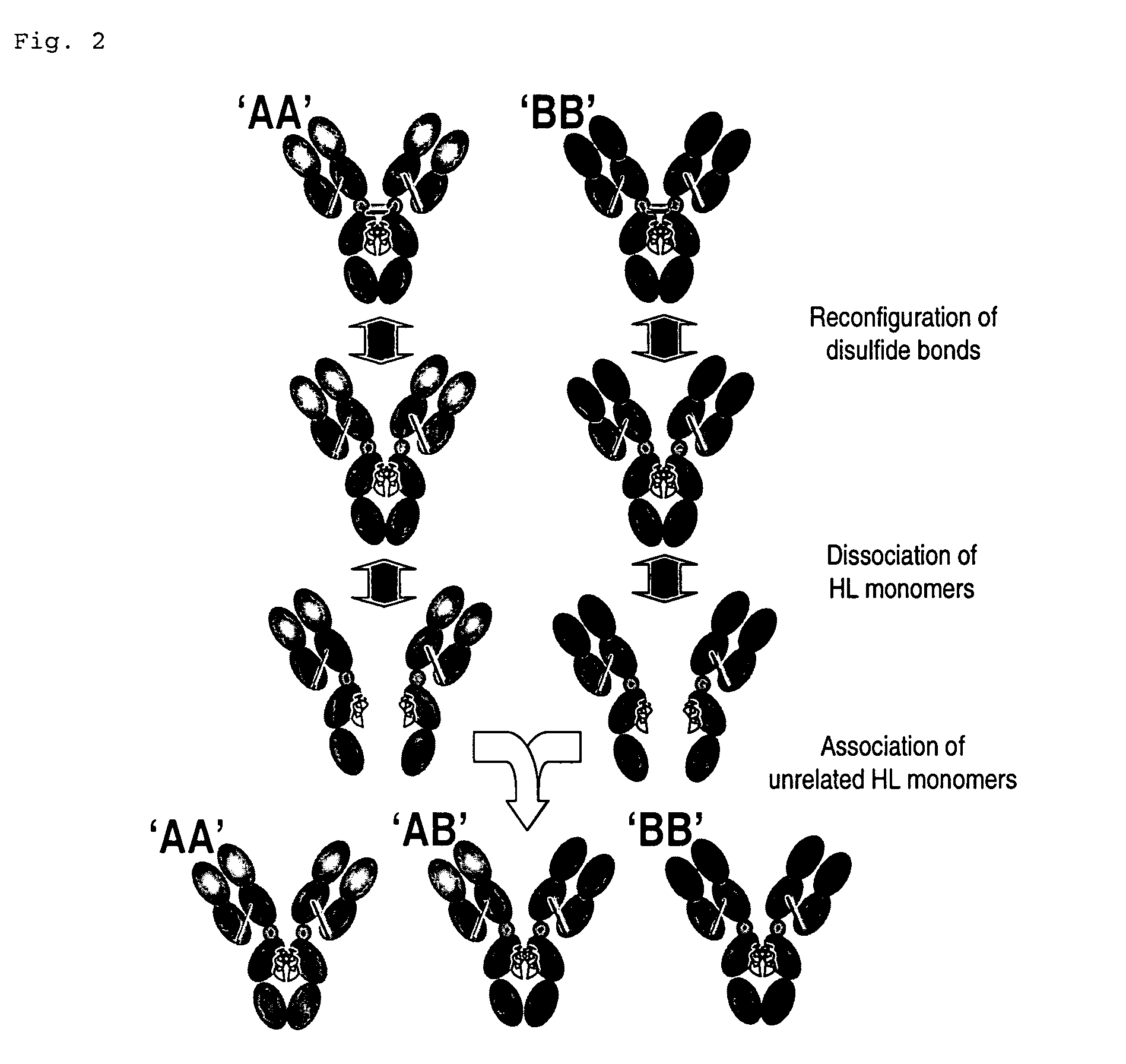Methods for generating multimeric molecules
- Summary
- Abstract
- Description
- Claims
- Application Information
AI Technical Summary
Problems solved by technology
Method used
Image
Examples
example 1
In Vitro Formation of Bispecific Antibodies
[0054] The anti-tumor necrosis factor-α (TNF-α) antibody cA2 G4 and anti-tissue factor (TF) antibody CNTO 859 were used to prepare bispecific anti-TNF-α / anti-TF antibodies. The cA2 G4 antibody is a mouse-human IgG4 chimeric monoclonal antibody against human TNF-α with an intact human IgG4 hinge region. The cA2 G1 antibody is an IgG1 version of cA2 G4 containing a human IgG1 hinge region. The CNTO 859 antibody is a humanized IgG4 monoclonal antibody against human TF with an intact human IgG4 hinge region. The CNTO 859 Fab fragment lacks the IgG4 hinge region and Fc domains.
[0055] Test samples containing the CNTO 859, cA2 G4, or cA2 G1 antibodies or CNTO 859 Fab as indicated in FIG. 3 were prepared in D-PBS at neutral pH such that the final concentration of each antibody during their coincubation was approximately 71 μg / ml. Test samples were incubated for 1 hr at room temperature.
[0056] The test samples were assayed for the formation of bi...
example 2
Inhibition of Bispecific Antibody Formation in Vitro
[0059] The effect of competitor IgG4 antibodies on the formation of bispecific IgG4 anti-TF / TNF-α antibodies was examined. The α-CD18 IgG4 antibody CNTO 3254 is a mouse-human chimeric monoclonal antibody against human CD18 containing an intact human IgG4 hinge region. The α-CD4 IgG4 antibody CNTO 4132 (or cM-T413) is a mouse-human chimeric monoclonal antibody against human CD4 containing an intact human IgG4 hinge region.
[0060] Recombinant human TNF-α or BSA was coated onto 96-well EIA plates by placing 50 μl of a 1 μg / ml solution of TNF-α or BSA in D-PBS in the wells and incubating at room temperature for 1 hr followed by storage at 4° C. The CNTO 859 and cA2 G4 antibodies were then mixed together in D-PBS at neutral pH in the presence of the cA2 IgG1 control, α-CD18 IgG4, and cM-T413 IgG4 competitor antibodies. The final concentration of the CNTO 859 and cA2 G4 antibodies was approximately 41 μg / ml while the competitor antibodi...
example 3
Time of Formation of Bispecific Antibodies in Vitro
[0063] The time course of formation of human TNF-α / TF bispecific antibodies at room temperature was examined. Recombinant human TNF-α or BSA was coated onto 96-well EIA plates by placing 50 μl of a 1 μg / ml solution of TNF or BSA in D-PBS in the wells and incubating at room temperature for 1 hr followed by storage at 4° C. The CNTO 859 and cA2 G4 antibodies were then placed in D-PBS at neutral pH as indicated in FIG. 5. The final concentration of the CNTO 859 and cA2 G4 antibodies was approximately 41 μg / ml. Samples were incubated in vitro at room temperature.
[0064] Samples prepared in vitro were assayed for the formation of bispecific antibodies at the time points indicated in FIG. 5. Bispecific antibody assays were performed as described in Example 1.
[0065] The results in FIG. 5 show that maximal bispecific antibody formation occurs in vitro approximately 30 minutes after antibody mixing and is detectable as early as 15 minutes ...
PUM
| Property | Measurement | Unit |
|---|---|---|
| Temperature | aaaaa | aaaaa |
Abstract
Description
Claims
Application Information
 Login to View More
Login to View More - R&D
- Intellectual Property
- Life Sciences
- Materials
- Tech Scout
- Unparalleled Data Quality
- Higher Quality Content
- 60% Fewer Hallucinations
Browse by: Latest US Patents, China's latest patents, Technical Efficacy Thesaurus, Application Domain, Technology Topic, Popular Technical Reports.
© 2025 PatSnap. All rights reserved.Legal|Privacy policy|Modern Slavery Act Transparency Statement|Sitemap|About US| Contact US: help@patsnap.com



